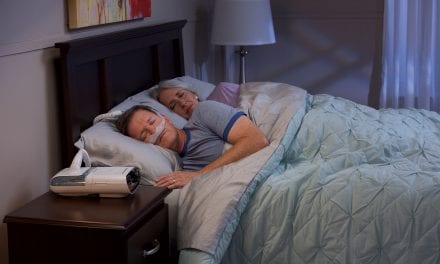ResMed Inc announced that people with obstructive sleep apnea who develop central sleep apnea (CSA) are more compliant on therapy after they switch from continuous positive airway pressure (CPAP) therapy to adaptive servo-ventilation (ASV) therapy, according to the largest-ever analysis of patients with treatment-emergent CSA.
The study analyzed anonymous, aggregated data from the devices of 198,890 telemonitored patients in the United States who were receiving positive airway pressure therapy for their sleep apnea. It showed that those with treatment-emergent CSA who switched from CPAP to ASV used their therapy longer and had significantly fewer apneas (breathing stoppages or reductions) during sleep:
- 62.7%: Patients’ compliance on CPAP prior to switching
- 76.6%: The same patients’ compliance after switching to ASV
“Achieving compliance through proper therapy usage is a well-recognized clinical goal in sleep apnea management, and one that is often hard to achieve, particularly in difficult-to-treat patients who may have untreated central sleep apnea,” says Carlos Nunez, MD, ResMed’s chief medical officer, in a release. “These findings underscore the importance of continuously monitoring central sleep apnea and rethinking the conventional wisdom on therapeutic options based on each patient’s disease severity.”
This retrospective analysis compared compliance rates of 198,890 patients using anonymous, aggregated telemonitoring data from a US PAP therapy database. Three groups of patients were analyzed for compliance, device usage, and measures of disease severity: Those patients that started and stayed on CPAP (the “CPAP-only” group), patients that started and stayed on ASV (the “ASV-only” group), and patients that started on CPAP and switched to ASV (the “Switch” group). All patients in the analysis received CPAP via ResMed’s AirSense 10 or ASV via ResMed’s AirCurve 10 devices.
The study used the U.S. Medicare definition of compliance: device usage for more than four hours per night on 70% of nights during a consecutive 30-day period anytime during the first three months of initial use.
In the “Switch” group, patients beginning on CPAP had the lowest initial compliance rate at 62.7%, but improved to 76.6% after switching to ASV. The low initial compliance seen in the Switch patients is possibly due to untreated CSA, based on their overall higher AHI—specifically their central apnea index (CAI)—during week one of therapy compared to the CPAP-only group. The 90-day compliance rates seen for the CPAP-only and ASV-only groups were 73.8% and 73.2%, respectively. In the Switch group, average residual AHI also decreased significantly (reduction from 17.2±0.9/h to 4.4±0.3/h) after the switch, indicating that ASV reduced both obstructive and central events.
Mean device usage at 90 days was similar for ASV in the Switch group with a rate of 5.73 hours per day, compared to 5.27 and 5.31 for the CPAP-only and ASV-only groups, respectively.
The study results were presented in an abstract at The European Respiratory Society and European Society of Sleep Research 2017 Sleep and Breathing conference in Marseilles, France.




